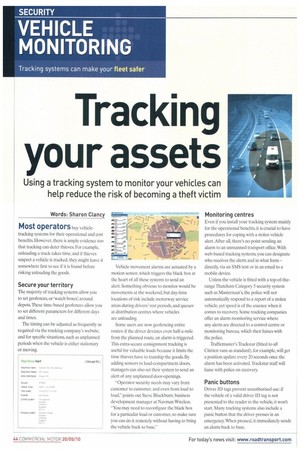Tracking your assets
Page 44

Page 45

If you've noticed an error in this article please click here to report it so we can fix it.
Using a tracking system to monitor your vehicles can help reduce the risk of becoming a theft victim
Words: Sharon Clancy Most operators buy vehicletracking systems for their operational and cost benefits. However, there is ample evidence too that tracking can deter thieves. For example, unloading a truck takes time, and if thieves suspect a vehicle is tracked, they might leave it somewhere first to see if it is found before risking unloading the goods.
Secure your territory The majority of tracking systems allow you to set geofences, or 'watch boxes', around depots. These time-based geofences allow you to set different parameters for different days and times.
The timing can be adjusted as frequently as required via the tracking company's website, and for specific situations, such as unplanned periods when the vehicle is either stationary or moving. Vehicle movement alarms are actuated by a motion sensor, which triggers the black box at the heart of all these systems to send an alert. Something obvious to monitor would be movements at the weekend, but day-time locations of risk include motorway service areas during drivers' rest periods, and queues at distribution centres where vehicles are unloading.
Some users are now geofencing entire routes: if the driver deviates even half-a-mile from the planned route, an alarm is triggered. This extra-secure consignment tracking is useful for valuable loads because it limits the time thieves have to tranship the goods. By adding sensors to load-compartment doors, managers can also set their system to send an alert of any unplanned door-openings.
"Operator security needs may vary from customer to customer, and even from load to load," points out Steve Blackburn, business development manager at Navman Wireless. -You may need to reconfigure the black box for a particular load or customer, so make sure you can do it remotely without having to bring the vehicle back to base." Monitoring centres Even if you install your tracking system mainly for the operational benefits, it is crucial to have procedures for coping with a stolen vehicle alert. After all, there's no point sending an alarm to an unmanned transport office. With web-based tracking systems, you can designate who receives the alerts and in what form — directly, via an SMS text or in an email to a mobile device.
Unless the vehicle is fitted with a top-of-therange Thatcham Category 5 security system such as Mastemaues, the police will not automatically respond to a report of a stolen vehicle, yet speed is of the essence when it comes to recovery. Some tracking companies offer an alarm monitoring service where any alerts are directed to a control centre or monitoring bureau, which then liaises with the police.
Trafficmaster's Trackstar (fitted to all Citroen vans as standard). for example, will get a position update every 20 seconds once the alarm has been activated. Trackstar staff will liaise with police on recovery.
Panic buttons Driver ID tags prevent unauthorised use: if the vehicle of a valid driver ID tag is not presented to the reader in the vehicle, it won't start. Many tracking systems also include a panic button that the driver presses in an emergency. When pressed, it immediately sends an alarm back to base.
Covert tracking
The latest self-contained tracking units offer lots of opportunities to track goods, vehicles or plant covertly. "The latest units are the size of a business card and are easy to hide," points out Quartix's Andy Kirk. "There's no external antenna, which means there's no connecting wire to help thieves locate the black box and disable it."
CMS Technologies is another company offering a discreet tracking unit, the SupaTrak Solo. The GPS and GSM antennas are housed in a compact weatherproof case, which is attached to any steel surface via built-in magnets. The unit has a tamper switch, which immediately sends out notification if it is removed.
Stopping the jammers
There are increasing reports of determined thieves using GPS jammers to disrupt the communication between the vehicle black box and the satellite, says Ian Platt, managing director of vehicle tracking specialist Automotion:"It is difficult to design integral anti-theft measures into any fleet management system that relies on GPS satellites for location data." He concedes that newer GPS systems are smaller and have integral aerials, so can be more covertly placed on the vehicle. "However, the unit is still relying on a clear view of the sky to receive the location data form the satellite."
Automotion's Sure-track MT2 is a covert, battery-powered tracking system that combines GSM mobile phone network technology with radio beacon transmitters, and includes motion and tamper sensors In place of a UPS satellite receiver, locations are determined by using the mobile phone network and cell-ID phone the unit knows which phone mast the unit is closest to and sends the data over RF network. The unit is programmed to wake up and report in at predetermined intervals "This makes it virtually undetectable, unlike tracking systems which are broadcasting a signal almost continuously," says Platt. Sure-track operates its own Under network, including recovery of the vehicle.
Tracker claims its VHF-based stolenvehicle recovery system is also jam-proof. The UK's 52 police forces have vehicles equipped with receivers that can home in any signal transmitted by vehicle equipped with a Tracker system.
Now the company has launched Tracker Locate that combines GPS-GSM with its established VHF technology.
"It allows operators to use GSM to send and receive data and GPS for location. However, should thieves attempt to jam the location signal, the unit will automatically switch to VHF;" says technical director John Sharpe.
"VHF is not dependent on a clear view of the sky, so vehicle can be tracked inside buildings and containers." •








































































































































































